Southeast Michigan vegetable update – June 10, 2020
Warmer temperatures bring plant growth but have also dried soils.

Weather
Last weekend’s cool weather was good for getting plants in but the hot, dry conditions that followed haven’t been great for transplanting. Southeast Michigan overall has been dry and missed some of the rainfall other parts of the state have received. Today, June 10, will bring a change, with high winds and sever weather ushering in another bout of cool, dry weather that should last into the next week.
If you use the Deerfield Enviroweather station, note that it is currently experiencing technical difficulties. The Michigan State University Enviroweather team is working on getting the station up and running up.
The table below shows rainfall totals for the Michigan State University Enviroweather stations in southeast Michigan, as well as degree-days calculated using the Baskerville-Emin Method. Degree-day average for Commerce and Hudson is over five years, while Deerfield is over four years. Soil temperature range in Fahrenheit at 2-inch soil depth over the last week, and rainfall is in inches. Frozen precipitation is not included. For a refresher on degree-days and how to get this information in your area, see “Accessing growing degree days with Enviro-weather” from MSU Extension.
|
Rainfall and degree day totals as of June 10 |
||||
|---|---|---|---|---|
|
Station |
Degree days (base 42) |
Degree days (base 50) |
5-year degree day average (base 50) |
Rainfall since April 1 |
|
Commerce |
919 |
517 |
542.6 |
7.08 (+0) |
|
Deerfield |
NA |
NA |
647.1 |
NA |
|
Hudson |
912 |
506 |
592.9 |
7.69 (+0.53) |
General notes
We are entering a window when corn and soybean growers make herbicide applications. This, parred with changing registration situation with dicamba products, highlights the need to talk to your neighbors about the sensitive vegetable crops you grow. While this talk about vegetables and spray drift can be awkward, that discomfort is minor compared to the drift complaint process and potential lost yield after an off-target drift incident.
The last few days have seen high temperatures that held overnight, as well as high humidity. This is unusual for this early in the season, and these conditions are ideal for disease development. Don’t be married to when the calendar says it is time to scout for diseases. The weather conditions have been all over the place this year, and the conditions for disease development have been consistently present earlier than usual. We have also had many periods of south to north airflow, which create opportunities for spores to move from southern production areas into northern ones. Past experience may suggest it is too early for many diseases, but this set of conditions warrant careful scouting.
On the same note, all the south to north airflow is likely to bring migratory insects. We have seen this already this year with reports of armyworm and cutworm. With the remnants of Tropical Storm Cristobal moving west of Michigan, the crystal ball suggests this could facilitate the movement of aphids and the viruses they carry.
Crop updates
Asparagus harvest will wrap up soon. The time between the last picking and fern emergence is a key window for asparagus weed control. An effective weed control strategy is to do a final, clean pick of all spears followed by an application of Roundup 4L. MSU Extension’s “Watch the timing for post-harvest weed control in asparagus” addresses the nuances of products and timing.

Cole crop pests are out. Cabbage maggot damage is evident in some fields. Swede midge damage can also be found sporadically.
Diamondback moth caterpillars are the main caterpillar pest I saw this week, many of which have finished feeding and are now pupae. The next generation of moths will emerge from these pupae after four to 15 days. These moths will lay eggs, and the eggs hatch five to six days later.
Garlic plants are starting to produce scapes. Research has shown removing scapes results in larger bulbs.
Pumpkins are starting to emerge.
Sweet corn is knee-high is the most far along plantings.
Reach out
Please contact me at schuhmar@msu.edu or 517-264-5309 with questions, concerns or to schedule a field visit. I have the ability to do field visits on a limited basis.
Great Lakes Vegetable Producer’s Network
The Great Lakes Vegetable Producer's Network is a live weekly roundtable discussion during the growing-season for commercial vegetable producers in the Great Lakes and Midwest region. It is broadcast live via Zoom at 12:30 ET/11:30 CT every Wednesday from the first week of May to the first week of September. Listen live or later. If you have a pressing vegetable production issue that you would like discussed, simply email it, along with your phone number, to greatlakesvegwg@gmail.com.
Next week, June 17, will cover predicting pest pressure.



 Print
Print Email
Email

